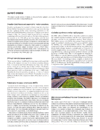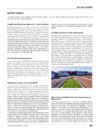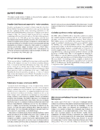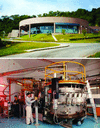issue contents
September 2004 issue

Cover illustration: Simulated coherent X-ray diffraction pattern by a nonperiodic specimen made of 2894 gold atoms using an energy-recovery linac synchrotron source proposed at Cornell University, see Shen, Bazarov and Thibault, pages 432-438. The color scheme indicates signal levels from 2 (dark purple) to 500 (red) in 20 equal logarithmic steps.
facility information
obituaries
Free 

research papers
The automation of the EMBL Hamburg wiggler beamline BW7B for protein crystallography is described. The beamline features an automated end-station, a robotic sample changer, semi-automated sample centering based on UV fluorescence and new control software including intuitive graphical user interfaces.
An X-ray BBB interferometer has shown intensity oscillations when its front mirror was displaced by a piezoelectric disc translator. These were caused by the change in the length of the front path while that of the back path stayed constant.
X-ray waveguides can routinely compress incident X-ray beams to submicrometre dimensions. State-of-the-art one- and two-dimensional waveguides are found to provide transmission efficiencies of 50% for spatially coherent incident radiation in each dimension.
A novel device for selecting and rejecting a specific undulator harmonic in synchrotron radiation experiments is described and tested. The device can be used to effectively extend the working energy range of monochromators.
Open  access
access
 access
accessThe undulator beamline of the Biophysics Collaborative Access Team (BioCAT), a national user facility designed and dedicated to the study of partially ordered and disordered biological materials, is described and examples of its capabilities are presented.
Imaging plates have been used in Weissenberg flat-cone geometry to rapidly collect reciprocal space maps of InGaN/GaN/AlN multilayers. The maps obtained with imaging plates were compared with triple-axis diffractometry results.
The promotion of Pt on Co/Al2O3 catalysts for Fischer-Tropsch synthesis was studied by EXAFS and XANES at both the Co K edge and Pt LIII edge. Direct contact of Pt with the active Co clusters was established by EXAFS, while XANES revealed that Pt assists in promoting the reduction of Co clusters interacting with Al2O3, thereby increasing the number of surface Co metal active sites.
The feasibility of X-ray absorption spectroscopy and X-ray magnetic circular dichroism at high pressure at the Fe K edge on the ID24 energy-dispersive beamline of the ESRF is demonstrated.
Micro-SXRF was used successfully to study the origins of individual aerosol particles. A method based on the analysis of individual aerosol particles combined with a pattern recognition technique was developed to identify the sources of PM10.
Experimental opportunities in coherent diffraction imaging with an iterative phasing algorithm are discussed based on the coherent properties of the proposed energy-recovery linac source.
short communications
The amplitude of an anomalous oscillation of X-ray Pendellösung interference fringes is compared with the distribution of fringe contrast on a quantitative basis in order to clarify that the fringe-oscillation amplitude is in good correlation with the reciprocal of fringe contrast.
new commercial products
Free 

current events
Free 

Free 

Free 

Free 

Free 

Free 

Free 

Free 



 journal menu
journal menu













































